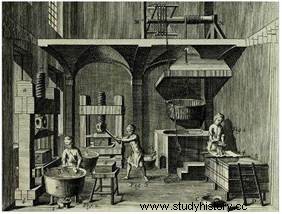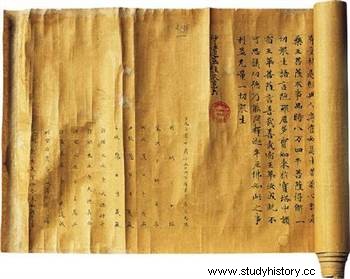 The Invention of Paper is attributed to the Chinese, who developed it around the year 100 from mulberry bark and exploited it for nearly five centuries before introducing it to Japan around the year 610. The process is relatively simple:first, the dissolution of the raw material in water, in the form of fibers, then its transformation into sheets by drying on a porous surface. Paper is used for writing and printing, for wrapping and packaging, and for various very specific applications:from the manufacture of filters to that of certain building materials.
The Invention of Paper is attributed to the Chinese, who developed it around the year 100 from mulberry bark and exploited it for nearly five centuries before introducing it to Japan around the year 610. The process is relatively simple:first, the dissolution of the raw material in water, in the form of fibers, then its transformation into sheets by drying on a porous surface. Paper is used for writing and printing, for wrapping and packaging, and for various very specific applications:from the manufacture of filters to that of certain building materials.
The invention of paper:a Chinese discovery
The oldest known and still existing paper was made from rags in the Han Dynasty, around 150 AD. J.-C, and seems to come from the involuntarily prolonged soaking of hemp rags and fall. Subsequently, the material used was probably mulberry bark and the paper was made on a mold made of bamboo strips. In the 2nd century AD, the high official of the imperial court Cai Lun is said to be at the origin of the improvement of the papermaking technique.
 Paper is fast becoming a new alternative to wood, papyrus, bone parchment and cloth for writing. For about five hundred years, the art of papermaking was reserved for China, but in 610 the secret of papermaking was transmitted to Japan, then to Central Asia around 750. Paper first appeared in Egypt in 9th century, but it was not made there until the 10th century.
Paper is fast becoming a new alternative to wood, papyrus, bone parchment and cloth for writing. For about five hundred years, the art of papermaking was reserved for China, but in 610 the secret of papermaking was transmitted to Japan, then to Central Asia around 750. Paper first appeared in Egypt in 9th century, but it was not made there until the 10th century.
Paper comes to Europe
It is then found in Spain, introduced by the Moors, where it is made in the 12th century before spreading throughout Europe and becoming more democratic, in particular thanks to a sort of antique typewriter developed by Gutenberg . This discovery then allows the massive printing of books. The use of paper mills increased production, particularly in the 17th and 18th centuries, and caused significant shortages of cloth . This drives manufacturers to look for alternatives, but also to reduce manufacturing costs.
These efforts resulted in the development of the first pulp-making machine by French inventor Nicolas Robert , in 1798. Then the brothers Henry and Sealy Fourdrinier improved the process in 1803. It was not until 1840 and the invention of the mechanical pulping process to reduce raw material costs. About ten years later, chemical pulp processes made their appearance.
To go further
- The fabulous history of paper, by Michel Vernus. 2004
- The Fabulous History of Inventions - From mastery of fire to immortality. Dunod, 2018.
